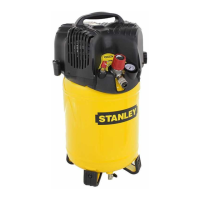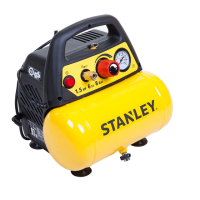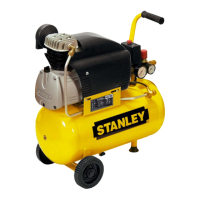G
B
19
5. PRE-START PROCEDURES
● Examine the machine for signs of transport damage.
Report any damage immediately to the company which
delivered the compressor.
● Verifythatthetankshavebeendrainedandareclearof
any moisture or dirt.
● The compressor should be set up near the working
consumer.
● Avoidlongairlinesandlongsupplylines(extensions).
● Makesuretheintakeairisdryanddust-free.
● Donotsetupthecompressorindamporwetrooms.
● The compressor may only be used in suitable rooms
(withgoodventilationandanambienttemperaturefrom
+5°Cto+40°C).Theremustbenodust,acids,vapours,
explosive gases or inflammable gases in the room.
● Thecompressorisdesignedtobeusedindryrooms.It
is prohibited to use the compressor in areas where work
is conducted with sprayed water.
6. OPERATION INSTRUCTIONS
6.1 Start-Up Procedures
1. VerifythattheOn/OffswitchisintheOffposition.
2. Verify that the tank air pressure is at 0 PSI.
3. Attach the air hose to the discharge line.
4. Plug the unit into a properly grounded outlet.
5. Push the On/Off switch to On. The On/Off switch
will light-up to indicate the compressor is on. The
compressor will automatically cycle on and off to keep
the tank pressure maintained .
6. Adjust the pressure regulator to the proper pressure
settingrequiredfortheairtool.
6.2 Shut-Off Procedures
1. PushintheOn/OffswitchtotheOffposition.
7. CLEANING AND MAINTENANCE
Warning!
Pull the power plug before doing any cleaning and
maintenance work on the appliance.
Warning!
Wait until the compressor has completely cooled
down. Risk of burns!
Warning!
Always depressurize the tank before carrying out any
cleaning and maintenance work.
7.1 Cleaning
● Keep the safety devices free of dirt and dust as far
aspossible.Wipetheequipmentwithacleanclothor
blow it with compressed air at low pressure.
● We recommend that you clean the appliance
immediately after you use it.
● Clean the appliance regularly with a damp cloth
and some soft soap. Do not use cleaning agents or
solvents;thesemaybeaggressivetotheplasticparts
in the appliance. Ensure that no water can get into the
interior of the appliance.
● Youmustdisconnectthehoseandanysprayingtools
from the compressor before cleaning. Do not clean the
compressorwithwater,solventsorthelike.
7.2 Draining tank
The condensation water must be drained off each day
byopeningthedrainvalve(ref.E)(onthebottomofthe
pressurevessel).
Draining the tank (a correct use of the drain valve -
pic. 3):
1. Verify that the compressor is turned Off.
2. Holding the handle, tilt the compressor toward the
drainvalvesothatit’ssetinalowerposition.
3. Open the drain valve.
4. Keep the compressor tilted until all moisture has been
removed.
5. Close the drain valve.
Warning!
The condensation water from the pressure vessel
will contain residual oil. Dispose of the condensation
water in an environmentally compatible manner at the
appropriate collection point.
7.3 Safety valve (ref. G)
The safety valve has been set for the highest permitted
pressure of the pressure vessel. It is prohibited to adjust
the safety valve or remove its seal. Actuate the safety valve
fromtimetotimetoensurethatitworkswhenrequired.
Pulltheringwithsufficientforce(pic.4)untilyoucanhear
the compressed air being released. Then release the ring
again.
7.4 Storage
Warning!
Pull the mains plug out of the socket and ventilate the
appliance and all connected pneumatic tools.
Switch off the compressor and make sure that it is
secured in such a way that it cannot be started up
again by any unauthorized person.
Warning!
Store the compressor only in a dry location which is
not accessible to unauthorized persons.
Always store upright, never tilted!
8. DISPOSAL AND RECYCLING
The unit and its accessories are made of various types of
material,suchasmetalandplastic.
Defective components must be disposed of as special
waste. Ask your dealer or your local council.

